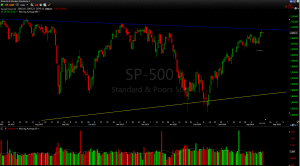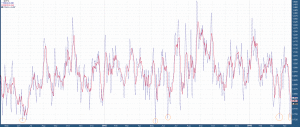After pretty much pinpointing the recent market bottom while the rest of those on Wall Street were running around with their faces melting off screaming bear market, we are now at a point in this upside cycle where things will become tricky enough that further analysis is warranted. When we last left off on March 6th, I pointed to the trajectory sitting around 2100 as the ultimate destination over the next few weeks for the current move up.
We are now sitting at this minor trajectory as pictured in the chart below for the S&P 500:
click chart to enlarge
At the same time, the put/call ratio is hitting levels of conviction, expressed through the purchase of calls, not seen since May/June of last year. This very simply tells market participants that bullish conviction has returned to the markets for the first time during this recent uptrend:
The minor trajectory pictured in the first chart paired up with excessive bullish sentiment, as expressed through the put/call ratio, more than likely translates to increased sideways volatility moving forward. It certainly doesn't translate into an imminent decline. The upside just becomes more difficult from here. It is similar to a cyclist who has been traveling on flat ground for ten miles and is then met by a two mile climb uphill. He doesn't stop peddling, his peddling just slows a bit.
There is enough momentum in this move up that we could indeed chop up towards 2150 before a top of any significance is seen.
My feeling towards this rally continues to be one where I feel it necessary to remind myself that the greatest danger is in becoming bearish too quickly. Despite the put/call ratio, there is a general skepticism regarding the prospects for continued upside among market participants. While somewhat anecdotal in nature, a bearish attitude is certainly pervasive among a majority of market participants to take notice.
If you're bearish on the market here you have a very distinct problem in that two factors are working against you:
- The economic data is not bearish enough to warrant an overwhelming of market dynamics to the downside. In other words, earnings aren't terrible, economic growth is decent, the Fed is slowly removing itself from the picture, emerging markets are improving and commodities have firmed up.
- Market participants are generally looking to sell at the first sign of trouble. Further, they remain prone to imagining trouble being present in places where it does not exist. When market participants become bearish too quickly, taking down exposure and/or shorting the market at the first sign of trouble, while possessing overactive imaginations, it creates shallow pullbacks UNLESS this fundamental market dynamic is overwhelmed by irrefutable, abundant evidence of economic deterioration.
At least for the time being, both of these factors will create support beneath the market that makes any tangible decline a low probability event.


